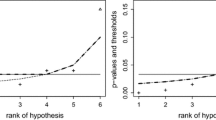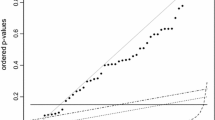Summary
Two-sided test procedures fork real parameters should point out in the case of rejection whether the left or the right alternative can be assumed. This sets up a multiple testing problem fork pairs of one-sided hypotheses. Holm's (1979, Scandinavian Journal of Statistics 6:65–70) sequentially rejective test provides a solution the critical levels of which are slightly improved. Considerable improvement is obtained when the hypotheses are redefined to be disjoint in pairs.
Similar content being viewed by others
References
Holm S (1977) Sequentially rejective multiple test procedures. Statistical Research Report 1977-1, University of Umea, Sweden
Holm S (1979) A simple sequentially rejective multiple test procedure. Scand J Statist 6:65–70
Marcus R, Peritz E, Gabriel KR (1976) On closed testing procedures with special reference to ordered analysis of variance. Biometrika 63:655–660
Shaffer J (1980) Control of directional errors with stagewise multiple test procedures. Ann Statist 8:1342–1347
Sonnemann E (1982) Allgemeine Lösungen multipler Testprobleme. EDV in Med u Biol 13:120–128
Author information
Authors and Affiliations
Rights and permissions
About this article
Cite this article
Bauer, P., Hackl, P., Hommel, G. et al. Multiple testing of pairs of one-sided hypotheses. Metrika 33, 121–127 (1986). https://doi.org/10.1007/BF01894737
Received:
Issue Date:
DOI: https://doi.org/10.1007/BF01894737




